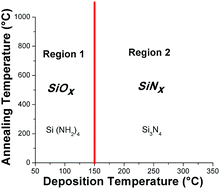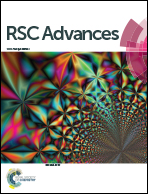Combined study of the effect of deposition temperature and post-deposition annealing on the photoluminescence of silicon quantum dots embedded in chlorinated silicon nitride thin films†
Abstract
Chlorinated-silicon nitride (SiNx:Cl) thin films with embedded silicon quantum dots (Si-QDs) were grown by remote plasma enhanced chemical vapor deposition using SiH2Cl2, H2, NH3 and Ar at different deposition temperatures (DT) in the range of 50 to 350 °C and using steps of 50 °C. After that, each sample was subjected to annealing treatments at temperatures (AT) of 400, 700 and 1000 °C. The evolution of the optical properties, composition and structure as a function of DT and AT were investigated by Null Ellipsometry, photoluminescence (PL) measurements, UV-Vis spectroscopy, X-ray Photoelectron Spectroscopy (XPS), Fourier Transform Infrared Spectroscopy (FTIR), scanning electron microscopy with energy-dispersive X-ray spectroscopy (SEM) with (EDS) and High Resolution Transmission Electron Microscopy (HRTEM). A red-shift in the PL peak and an increment in the PL integrated intensity of the films was found on increasing DT from 150 to 350 °C; such changes can be explained by modifications of the matrix chemical composition and by the quantum confinement effect due to an increase in the size and density of Si-QDs respectively. A chemical analysis revealed that films deposited below 150 °C suffer a post-deposition oxidation process leading to the formation of silicon oxide; this process is accelerated by the temperature of the annealing treatment. Meanwhile films deposited between 150 and 350 °C are mainly composed of silicon nitride that diminishes the mentioned oxidation due to the thermal treatments and promotes the splitting of Si-QDs into two populations with different average diameter. The annealed films deposited below 150 °C show a clearly decrement in the PL intensity, meanwhile the maximum emission PL peak from annealed films grown from 150 to 350 °C shifts to high emission energies. This post thermal annealing blue-shift can be mainly related to the nucleation of new small Si-QDs. We concluded that temperature is one of the most important mainstays to achieve good luminescence from Si-QDs.



 Please wait while we load your content...
Please wait while we load your content...